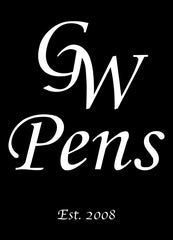News

The Pen Addict blog, Meet Your Maker - June, 2025:
https://www.penaddict.com/blog/2025/6/23/meet-your-maker-john-greco-gw-pens

Pen World Magazine, October 2024:





Pen World Magazine, December 2015:

The College of New Jersey Alumni Magazine, Fall 2017:



Pen World Magazine, October 2017:

Pen World Magazine, February 2018 (for the PDF click HERE):





The Philadelphia Inquirer - September 2018
In a storefront studio in small-town Jersey, artisan John Greco shapes shards of Americana — pieces of places and things freighted with historic or cultural import — into pens that are more art than writing implements.
Greco has made pens out of the wood from Independence Hall, the White House, the USS Constitution, the Grand Ole Opry, Ford's Theater, Jack Daniel's casks, Yankee Stadium, and the Sandy-wrecked boardwalk of Seaside Heights.
He's also fashioned pens from World War II ammunition, shredded cash embedded in resin, and marble from the same Colorado quarry that supplied the Lincoln Memorial.
On his lathes in a former women's consignment shop on South Main Street in Woodstown, Salem County, Greco creates heirloom-quality work that garners him international acclaim among pen cognoscenti.
"My pens," says Greco, 44, a North Jersey native who lives with his wife and two children in Sewell, Gloucester County, "are not from the mass-produced world."
Hailed as a "passionate, unique artist" by pen maven Nicky Pessaroff, the editor-in-chief of Houston-based Pen World magazine (with a digital and print readership of 30,000 and rising), Greco has crafted pens for Chris Christie, Barack Obama, Prince Harry, and Pope Francis.
Tactile, visual, meaty, weighted — Greco pens feel like integrity itself in the hand, priced from $60 to $2,000 each.
"I have an analog soul," says Greco, revealing the animating essence of his life's work.
In a blinking, chirping, digital world, the pen is mightier than the algorithm for Greco and his ilk, who respond to a growing nostalgia for the old and the real.
Authentic tools
The world has long admired and pocketed fancy pens from established companies, such as Cross, Mont Blanc and Montegrappa.
Around the country, though, independent pen makers are popping up everywhere, says Pessaroff. Many of them aren't dedicated artists like Greco. They're hobbyists who unwind at the end of the day by contemplating the gratifying aesthetics of hand-engineered writing instruments.
Mostly they make fountain pens, prized for their gold or stainless steel nibs that can create lines from linguine-thin to broadly expansive, gliding like schooners over thick and ink-thirsty paper.
For pen users of high-end fountain, roller ball, or ballpoint pens, these are glorious times. "Millennials are getting back to analog tools because they are looking for something authentic to work with," Pessaroff says. "They crave a non-disposable writing element that lasts the rest of your, your child's, and your grandchild's lives."
Pens and other writing tools generated $16.2 billion in worldwide sales in 2014, and are expected to reach $20.2 billion next year, according to Technavio, a market-research firm.
Much of the renewed need for pens is being fostered by expanded interest in handwritten journals, especially bullet journals, a form of capturing information about your past, present, and future in bulleted lists.
People learn soon enough that a good pen can even affect the quality of writing itself, Pessaroff says.
Who wouldn't pause an extra moment while wielding a fine writing implement to contemplate whether the correct next word should be "but," not "and," thus avoiding a messy cross-out that would only sully the page and devalue the entire creative process?
With such a pen in hand, one doesn't jot — one composes. One doesn't dash off a line to a friend — one corresponds.
‘My people’
Across America, pen shows are growing in number and size, including the largest pen gathering in the nation, the Washington, D.C. Fountain Pen Supershow, held every August. Around here, the big gathering is the Philadelphia Pen Show each January at the Westin Philadelphia.
When Greco first stepped into that exhibition hall (then at the Sheraton Hotel) in 2010 stocked with what seemed like acres of what he calls "the holy trinity" — pens, ink, and paper — he whispered to himself, "These are my people."
A lover of shop class as a kid, Greco, the product of a working-class family, made woodworking a hobby after he graduated with a political science degree from the College of New Jersey in 1997.
He handmade toys, then got a job at Staples, where being around pens "was a perk," he says. "I realized that I loved them. I'm a tactile person and I love the sense of the pen on the paper."
Greco made his first pen in 2010 and found his calling. "That's it," he declared. "I love this!"
He rented factory space in Pitman, then moved to the Woodstown store last October, calling it GW Pens (for Greco Woodworking). A local official remarked that seeing Greco work on pens in his front window brought to mind boardwalk taffy makers down the shore.
Greco believes his shop — in which he makes, displays, and sells his pens, and also has a small gallery of historic raw materials — is the only spot like it in the United States.
Pessaroff says he's not positive of that. But, he allows, GW Pens is rare.
Much of Greco's business is conducted online, with customers throughout America, as well as in Saudi Arabia, Australia, South Africa, Europe, and Japan.
Witness wood
For his historic pens, Greco gets so-called "Witness Wood" from Bob DeMartino of North Jersey, a collector of rare wood who founded History Salvaged L.L.C.
DeMartino says he owns the only wood officially documented to have been removed from Independence Hall in 1897 during a renovation.
He possesses official correspondence, complete with seals and notarized signatures, that attest to the wood's authenticity.
DeMartino says he sleuthed the wood's whereabouts through the years, tracking it from late 19th Century Philadelphia to the home of a Long Island attorney in 2014.
"Then it took me four years to convince him to sell me one four-foot beam and smaller pieces," DeMartino says. The afterglow from that triumph still warms him.
DeMartino says he enjoys working with Greco. DeMartino had distributed a bit of Witness Wood to some pen makers around America, to audition them. "Nothing they made came back good, except from John," he says.
The way it works is that DeMartino supplies Greco with historic wood free of charge. DeMartino pays Greco for the pens he makes with the wood, and the two share profits.
"John's meticulous, and his quality is second to nobody in the country," says DeMartino, who's especially impressed with Greco's ability to make pens out of marble and other stone, a toilsome process that foils other artisans, whose pens and patience crack apart with the effort.
Greco appreciates the kind words. And he figures the joy he derives from pens will keep him working in the business for decades more. He has, it turns out, only one pen-related complaint in life:
"I wish my handwriting were better."
by Alfred Lubrano

